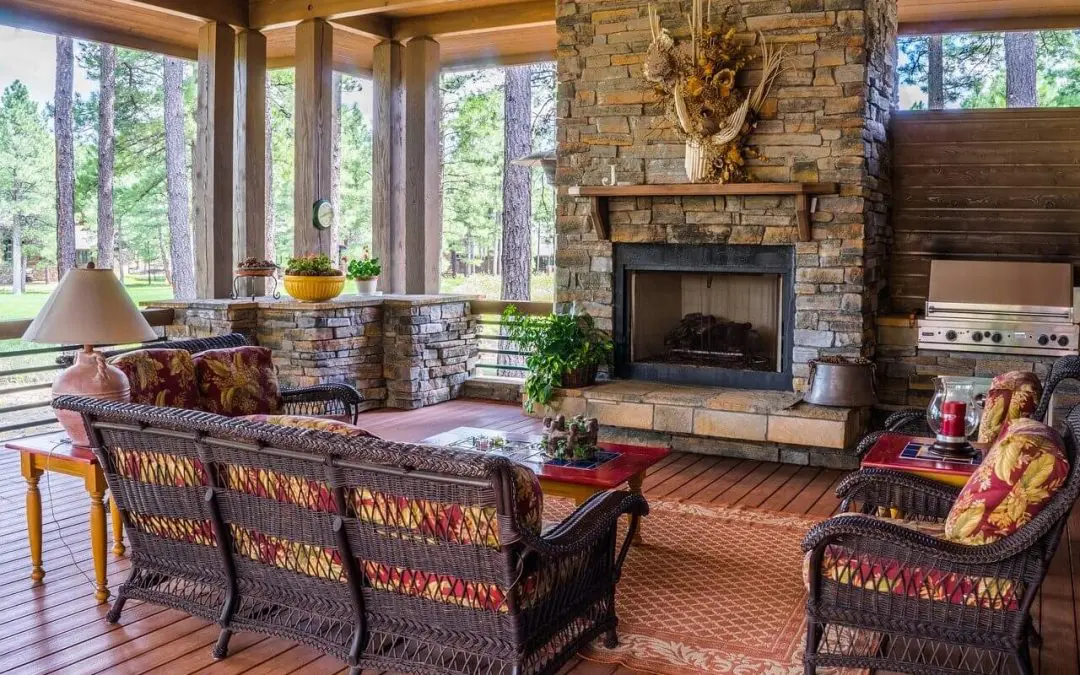Fall is here, and winter is fast approaching; there’s nothing quite as comforting as the warm glow of a crackling fireplace when it gets cold. However, before lighting that first fire of the season, it’s essential to ensure your fireplace is ready for use. Preparing your fireplace enhances its efficiency and ensures safety. Here’s a guide on how to prepare your fireplace for cozy nights ahead.
Inspect the Chimney and Flue Before You Prepare Your Fireplace
The first step in preparing your fireplace is inspecting the chimney and flue. Over the months when your fireplace is not in use, debris like leaves, twigs, or even animal nests can block the chimney. Creosote, a highly flammable residue from burning wood, can also accumulate in the chimney lining and pose a fire hazard if not properly cleaned.
A professional chimney sweep should inspect the flue annually to ensure no blockages, cracks, or signs of damage. If creosote buildup is detected, a thorough cleaning is essential to reduce the risk of chimney fires. A clean chimney ensures that smoke, gases, and soot are adequately vented out of your home, maintaining air quality and safety.
Check the Damper
The damper, located in the throat of the chimney, regulates airflow between your home and the chimney. Over time, it can get stuck or damaged, impacting your fireplace’s performance. Before the season starts, check that the damper opens and closes easily and seals tightly when closed.
A functional damper ensures your fireplace operates efficiently. When open, it allows smoke and gases to escape while also letting in oxygen for a clean burn. When closed, it prevents cold drafts from entering your home. If your damper is not functioning correctly, it might need repair or replacement before you start using the fireplace.
Clean the Fireplace Interior
Your fireplace is likely to have accumulated dust, soot, and ash from previous burns. Before starting a new fire, clean out the interior to create a fresh, safe space for burning.
Use a fireplace shovel to remove leftover ash and soot. Wear gloves and a mask, as the fine particles can be messy and irritate your lungs. Additionally, if your fireplace has any glass doors or enclosures, clean them thoroughly with a glass cleaner designed for fireplaces to remove soot buildup. A clean fireplace looks better and burns more efficiently, as airflow is improved.
Stock Up on Seasoned Firewood While You Prepare Your Fireplace
The type of wood you burn in your fireplace significantly impacts how well it operates. Seasoned firewood, which has been dried for at least six months, burns cleaner and produces less creosote than green or freshly cut wood. Ensure your wood supply is stacked in a dry, well-ventilated area and covered to keep it from absorbing moisture.
Avoid burning softwoods like pine, which tend to produce more creosote, and instead opt for hardwoods such as oak, hickory, or maple. These woods burn longer and hotter, providing better heat output and minimizing creosote buildup in your chimney.
Inspect and Test Smoke and Carbon Monoxide Detectors
Fireplaces can emit smoke and carbon monoxide, which are harmful if they enter your living space. A crucial part of preparing your fireplace for the season is ensuring that your smoke and carbon monoxide detectors are in good working condition.
Test the detectors throughout your home and replace the batteries if necessary. If your detectors are over 10 years old, consider replacing them entirely. Place carbon monoxide detectors near your fireplace and in bedrooms for added safety. This proactive step can protect you and your family from potential hazards that could arise from a malfunctioning fireplace.
Install or Check Your Fireplace Screen
A fireplace screen is an essential safety feature that prevents embers from escaping and causing damage to your home. If you already have a fireplace screen, inspect it for signs of wear or damage. Over time, screens can become bent, rusted, or have holes that allow embers to escape.
If you don’t have one yet, consider investing in a sturdy screen or glass door. In addition to safety, a well-maintained fireplace screen adds to the aesthetic appeal of your hearth and helps contain heat within the fireplace, making your home more energy-efficient.
Prepare for Proper Ventilation
While a roaring fire can make your home feel cozy, proper ventilation is key to ensuring your safety. Check the airflow in the room where your fireplace is located, ensuring vents or windows can be opened if necessary. A fire consumes oxygen, and without proper ventilation, your fire could burn inefficiently, producing more smoke and carbon monoxide.
Consider using a fireplace fan or blower to help circulate warm air throughout the room, maximizing your fireplace’s heat output. These devices help disperse the heat generated by the fire, making the room more comfortable without overloading the fireplace.
Schedule a Professional Inspection When You Prepare Your Fireplace
Though many fireplace maintenance tasks can be done by homeowners, having a professional inspect your fireplace and chimney is a smart move. A certified chimney sweep can identify potential issues such as cracks in the chimney lining, damaged flue tiles, or structural problems with the chimney. These are issues that may not be visible to the untrained eye but can pose serious risks if left unaddressed.
An annual inspection provides peace of mind, ensuring that your fireplace is safe to use for the entire season. Additionally, a professional can offer personalized advice on maintaining your specific fireplace type, whether it’s wood-burning, gas, or electric.
Enjoy the Warmth of Your Fireplace
Once you prepare your fireplace, you can look forward to a season of warmth and relaxation. These preparatory steps ensure that your fireplace will provide efficient, safe heating all season long. Whether you’re spending quiet nights at home or hosting gatherings, your fireplace will be ready to offer the cozy atmosphere that makes cold weather more enjoyable.
By following these tips, you’ll protect your home from potential hazards and maximize the charm that a well-maintained fireplace can bring. Now, all that’s left to do is sit back, relax, and enjoy the warmth.
FAQs
How often should I clean my fireplace?
It’s recommended to clean your fireplace at least once a year, preferably before the start of the season. However, if you use your fireplace heavily, consider cleaning it more frequently to avoid soot and creosote buildup, which can become fire hazards.
What is creosote, and why is it dangerous?
Creosote is a byproduct of burning wood. It accumulates in your chimney as a sticky, tar-like substance. Over time, creosote can build up, and because it is highly flammable, it increases the risk of a chimney fire. Regular chimney cleaning helps reduce creosote buildup.
Can I use my fireplace without cleaning it if I haven’t used it in a while?
Even if you haven’t used your fireplace in months, it’s essential to clean and inspect it. Debris, bird nests, or other obstructions may have accumulated in the chimney, which can prevent proper ventilation or cause dangerous situations.
How can I tell if my chimney needs cleaning?
Signs that your chimney needs cleaning include excessive smoke when the fireplace is lit, a strong odor coming from the fireplace, and visible black, tar-like buildup inside the chimney. If in doubt, it’s best to call a professional for an inspection.
JW Goad Home Inspections provides home inspection services in Clarksville, TN, and the surrounding areas. Contact us to schedule an appointment.

